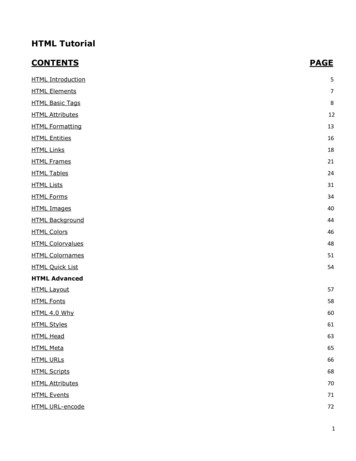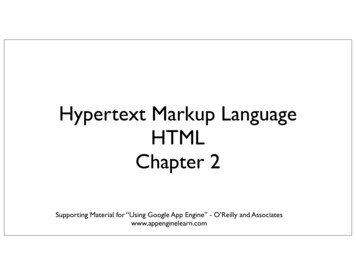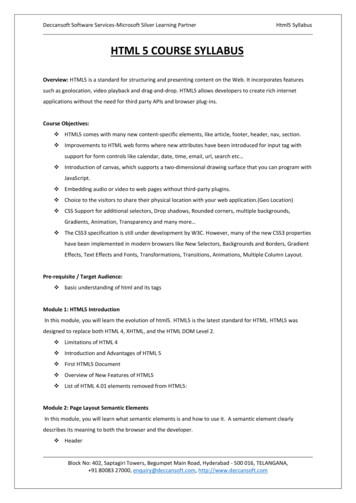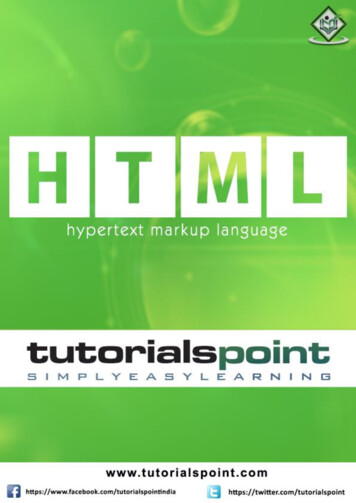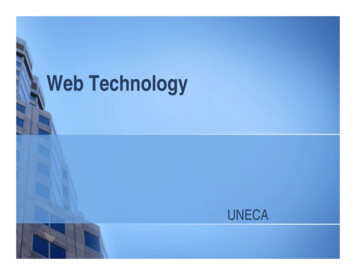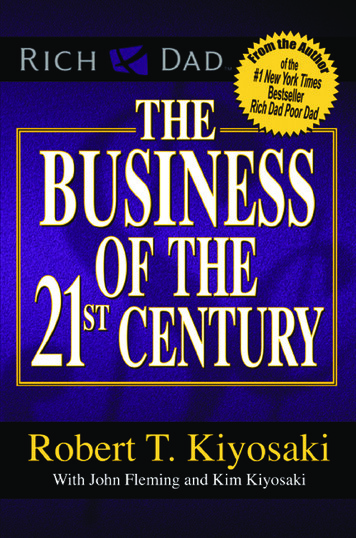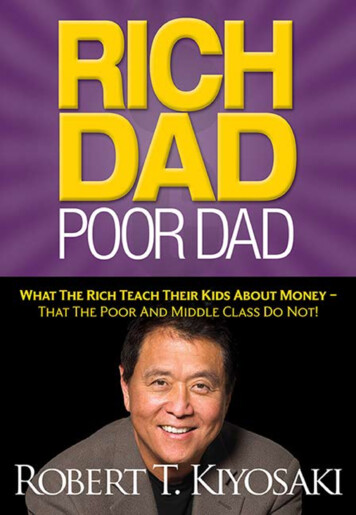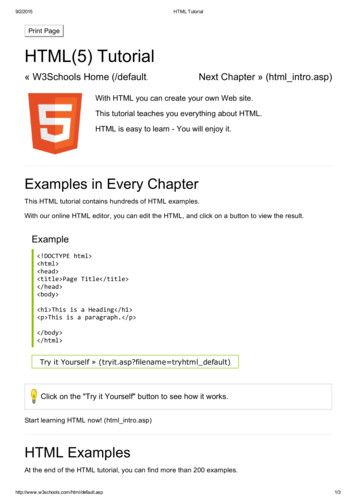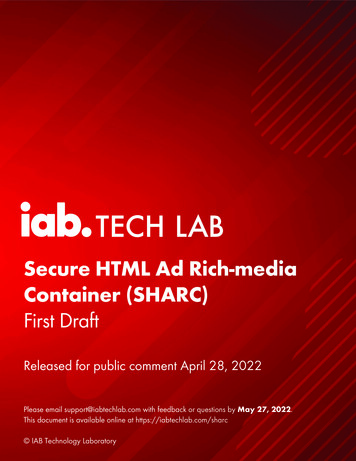
Transcription
Secure HTML Ad Rich-mediaContainer (SHARC)First DraftReleased for public comment April 28, 2022Please email support@iabtechlab.com with feedback or questions by May 27, 2022.This document is available online at https://iabtechlab.com/sharc IAB Technology Laboratory
Secure HTML Ad Rich-media Container (SHARC)OverviewSecure HTML Ad Richmedia Container (SHARC) is a secure container API for managedcommunication between an app or webpage and a served ad creative.Change LogVersionSummary1st draftInitial release to public commentAudienceDevelopers on the sell side for content platforms will need the details in this document forimplementing SHARC on their systems. On the buy side, creative developers will need thisdocument to develop display ads that make use of the SHARC APIs.About IAB Tech LabThe IAB Technology Laboratory (Tech Lab) is a non-profit consortium that engages a membercommunity globally to develop foundational technology and standards that enable growth andtrust in the digital media ecosystem. Comprised of digital publishers, ad technology firms,agencies, marketers, and other member companies, IAB Tech Lab focuses on improving thedigital advertising supply chain, measurement, and consumer experiences, while promotingresponsible use of data. Its work includes the OpenRTB real-time bidding protocol, ads.txt antifraud specification, Open Measurement SDK for viewability and verification, VAST videospecification, and DigiTrust identity service. Board members include ExtremeReach, Facebook,Google, GroupM, Hearst Digital Media, Index Exchange, Integral Ad Science, LinkedIn,LiveRamp, MediaMath, Microsoft, Oracle Data Cloud, Pandora, PubMatic, Quantcast, RakutenMarketing, Telaria, The Trade Desk, Verizon Media Group, Xandr, and Yahoo! Japan.Established in 2014, the IAB Tech Lab is headquartered in New York City with staff in SanFrancisco, Seattle, and London. Learn more at https://www.iabtechlab.com.This document has been developed by the Secure Ad Container Working Group.IAB Tech Lab Lead:Katie Stroud, Sr. Product Manager, Ad Experiences 2022 IAB Technology Laboratoryiabtechlab.com/sharcPage 1 of 46
Secure HTML Ad Rich-media Container (SHARC)Special Thanks to:Co-chairs on this project Jeffrey Carlson, Chartboost Aron Schatz, DoubleVerifyOther key contributors Kyle Grymonprez, Twitter Marian Rusnak, Verizon Bichen Wang, Chartboost Laura Evans, Flashtalking by Media Ocean Sarah Kirtcheff, Flashtalking by Media Ocean 2022 IAB Technology Laboratoryiabtechlab.com/sharcPage 2 of 46
Secure HTML Ad Rich-media Container (SHARC)TABLE OF CONTENTSOVERVIEW .1Change Log .1Audience.1About IAB Tech Lab .1Special Thanks to: .2INTRODUCTION .5GUIDING PRINCIPLES . 5SCOPE . 6Out of Scope .6GOALS . 6HOW IT WORKS .7THE RELATIONSHIP BETWEEN SIMID AND SHARC . 8SECURE BY DEFAULT .9API REFERENCE .9REFERENCE TABLE: CONTAINER . 9REFERENCE TABLE: CREATIVE . 9MESSAGES FROM THE CONTAINER . 10SHARC:CONTAINER:INIT . 10SHARC:CONTAINER:STARTCREATIVE . 17SHARC:CONTAINER:STATECHANGE. 18Table of possible container states. 19SHARC:CONTAINER:PLACEMENTCHANGE . 20SEE SHARC:CREATIVE:REQUESTPLACEMENTCHANGE . 23SHARC:CONTAINER:LOG . 23SHARC:CONTAINER:FATALERROR . 24SHARC:CONTAINER:CLOSE . 24MESSAGES FROM THE CREATIVE TO THE CONTAINER. 25SHARC:CREATIVE:FATALERROR . 25SHARC:CREATIVE:GETCONTAINERSTATE . 26SHARC:CREATIVE:GETPLACEMENTOPTIONS . 26SHARC:CREATIVE:LOG . 28SHARC:CREATIVE:REPORTINTERACTION . 28SHARC:CREATIVE:REQUESTNAVIGATION . 29SHARC:CREATIVE:REQUESTPLACEMENTCHANGE . 29SHARC:CREATIVE:REQUESTCLOSE. 31EXTENSIONS. 31 2022 IAB Technology Laboratoryiabtechlab.com/sharcPage 3 of 46
Secure HTML Ad Rich-media Container (SHARC)COMMON WORKFLOWS . 32LOADING (AD LIFECYCLE) . 32TYPICAL INITIALIZATION WORKFLOW . 34NON-SHARC CREATIVES . 34HOW TO HANDLE CLOSE SEQUENCE. 35HOW TO HANDLE NAVIGATION EVENT . 35HOW TO HANDLE INTERACTIONS . 35HOW TO HANDLE AD END AND UNLOAD. 35CREATIVE DELAYS RESOLVING INIT . 35CREATIVE REJECTS INIT . 36ERROR HANDLING AND TIMEOUTS . 36ERROR CODES . 36CONTAINER TIMES OUT . 38CREATIVE TIMES OUT . 38MESSAGING PROTOCOL. 38DATA LAYER . 38Data Structure. 39Messages Categories . 40reject Messages . 41TRANSPORT LAYER. 42postMessage Transport. 42Message Serialization . 42SESSION LAYER. 42Establishing a New Session . 43Session Establishing Delays and Failures . 44COMPATIBILITY MODES . 46COMPATIBILITY MODE WITH MRAID . 46COMPATIBILITY MODE WITH SAFEFRAME . 46 2022 IAB Technology Laboratoryiabtechlab.com/sharcPage 4 of 46
Secure HTML Ad Rich-media Container (SHARC)IntroductionSecure HTML Ad Richmedia Container (SHARC) is a secure container API for managedcommunication between an app or webpage and a served ad creative.SHARC is built on the same premise as two of IAB Tech Lab’s ad container standards:SafeFrame and Mobile Rich Ad Interface Definition (MRAID). SafeFrame was designed to runin-web and MRAID was designed to run in a webview in mobile in-app devices. The trouble withthese two standards is that they’re both very similar and yet different enough that you wouldhave to build two different ad creatives to run a campaign across both web and mobile.Several ad platforms have tried to build a bridge between the two APIs so that an MRAID adcould also run in a SafeFrame container and a SafeFrame ad could run in an MRAID container.Unfortunately, the differences are stark enough that these attempts at cross-compatibility neverreally worked out.The Safe Ad Container working group for ad experiences at IAB Tech Lab have started from theground up to build a standard for managing rich interactive display ads. Our motto for SHARCis:Build one ad; serve it everywhere.With SHARC, a creative developer can build one ad with all the available API functions andserve it to any connected display platform that has implemented SHARC. This is not just limitedto web or mobile in-app, it includes a variety of platforms (such as CTV) that are available todayand future platforms.Guiding principles PerformanceIndustry standards interoperabilityConsumer protectionPublisher safety and securityLow barrier of entry (simplicity and ubiquity)Minimize impact on key stakeholders in the supply chain (example: OMID included JSlibraries to reduce customization that impacted efficiency)No ambiguity (detailed specifics in both spec and implementation guide) - while also notdelaying release for the sake of clarifying, sub-groups to focus on blocking issues anddefying a process to get things doneExtensibility (helps enable testing of new features before implementing)Graceful degradation 2022 IAB Technology Laboratoryiabtechlab.com/sharcPage 5 of 46
Secure HTML Ad Rich-media Container (SHARC)ScopeSHARC is intended for managing rich media ad interactions in display placements. While videocan be included in the final creative, SHARC provides no playback controls or tracking. SHARCads can also be served into video players that have implemented SHARC and may be a greatway to handle non-linear and companion ads in video ad placements, but this spec does not yetcover that use case.Out of ScopeThe following ad tech operations are out of scope in SHARC: Ad requestAd deliveryMeasurementAd tracking and reportsWhile the above operations are out of scope for SHARC, they play a role in the success ofSHARC and certain SHARC functions either use or support these operations.For example IAB Tech Lab’s Advertising Common Object Model (AdCOM) is a standardizeddata structure for relaying details about the placement, the creative, the context, and any otherinformation that all parties in the supply chain need for placing, tracking, and reporting on the adexchanges in the campaigns they run. It is a dataspec used in the ad request and response,and SHARC requires data from the same dataspec to communicate some of these unchangingdetails as part of the initiation cycle. AdCOM is the default and preferred dataspec to use, butSHARC itself doesn’t supply any of this data; it only provides additional data expected tochange during runtime, such as the current state of the container, size changes, or volumedetails.The example above explains how other ad operations beyond loading and managinginteractions are left to other standards, thereby simplifying SHARC as much as possible. Thisseparation helps SHARC meet some of its guiding principles such as performance andinteroperability.GoalsWrite one ad; serve it anywhere.This is the key goal of SHARC. In order to achieve this goal, we must achieve certain supportinggoals to integrate SHARC into systems and operations that make up the digital advertisingsupply chain. 2022 IAB Technology Laboratoryiabtechlab.com/sharcPage 6 of 46
Secure HTML Ad Rich-media Container (SHARC)Adoption is dependent on the following: Producing a clear and unambiguous spec for SHARC implementers (this document) Providing guidance for different operational audiences targeted to their specific needs formaking use of SHARC Developing reference code, tools, and examples that simplify implementation Creating an awareness of the challenges that SHARC solves in the marketplace fordisplay advertising, especially where no solution currently exists Educating different audiences on the benefits and use of SHARC Regular updates to support growing market needsIf you would like to get involved, please reach out to support@iabtechlab.com and we’ll set youup. You can also visit our GitHub repository at https://github.com/IABTechLab/SHARC.How it worksSHARC is a protocol for managing ad interactions in a secure container that prevents an adfrom accessing data on the platform where the ad displays. In the most simplistic overview ofhow it works, the steps are as follows: [pre-SHARC] an ad is matched and delivered to the SHARC placementSHARC initiates. In this step, the following occurs: The SHARC-enabled platform creates the secure (IE: an iframe on web, webviewon mobile) container The SHARC container inserts the creative markup and the creative prepares itsresources Once in a state to receive SHARC information, the creative informs the containerthat it is ready to receive initialization information . The SHARC container initializes and provides the creative with data about thecontainer. Data about the environment (placement) and the creative is pulled from thedataspec (default is AdCOM) along with any runtime details such as current sizeand state and volume settings Once the creative and the container are ready, SHARC asks the creative to startand waits for the creative to respondCreative responds with “resolve” indicating that it is readyCreative executes, using SHARC functions to resize, navigate away from platform,close, etc.Upon completion of the ad experience, SHARC signals a close function and unloads thead. 2022 IAB Technology Laboratoryiabtechlab.com/sharcPage 7 of 46
Secure HTML Ad Rich-media Container (SHARC)A diagram and more detailed descriptions of different use cases are provided in the section onCommon Workflows.The relationship between SIMID and SHARCTo develop SHARC, we looked to the structure of SIMID as a model. SIMID is IAB Tech Lab’sSecure Interactive Media Interface Definition. Like SHARC, it uses a secure container tomanage an ad experience, except that SIMID functions in the context of a media player.Discussion on whether SIMID should be extended to also handle display ads across platformsor to develop a new standard (SHARC) to handle display ads separately from the SIMID videostandard was explored. The decision to create a separate standard emerged as part of thefollowing logic.As API specs and standards at IAB Tech Lab evolve, there is an opportunity to develop newAPIs with shared design principles of existing APIs. Doing so creates a firm foundation uponwhich new APIs can be built more rapidly while lowering the learning curve for the industry toadopt new specs.SHARC has opted to share the same messaging protocol and API structure that SIMIDdeveloped in order to take full advantage of this opportunity. Sharing this core messagingstructure has enabled SHARC to more rapidly prototype a spec tasked with being the crossplatform rich media successor to the Safe Frame and MRAID specs.In adopting a lot of the API design, features and functionality, a common question asked is whyshouldn’t SIMID solve all use cases?The three main reasons are specialization, flexibility and simplicity.1. For specialization, SIMID was created exclusively to provide rich interactivity forstreaming audio and video ads. Expanding its scope beyond its intended use case isexactly how its predecessor VPAID got into trouble. SHARC being separated as a richmedia container resolves any issues with SIMID becoming overloaded.2. For flexibility, it allows both SIMID and SHARC to develop separately as marketinnovations, needs and problems to be solved potentially fork former shared priorities.3. For simplicity, SIMID and SHARC can keep a focused API spec relevant to eachsolution. SHARC has no parallel use case for certain video functions, for example.These improvements can be updated independently without forcing unnecessary versionupdates on technology stacks.It is important to have different tools for different use cases. Use SIMID when working withVAST audio or video creative that need interactivity. Use SHARC when working with next-genrich media display HTML5 creative in web and other platforms. A use case for both specs couldbe a VAST creative with interactivity and a companion ad as an end card. SIMID would be usedto overlay the video and SHARC would be used to display the companion end card. 2022 IAB Technology Laboratoryiabtechlab.com/sharcPage 8 of 46
Secure HTML Ad Rich-media Container (SHARC)Secure By DefaultOne of the main tenets of SHARC is the focus on providing a robust and secure communicationand security framework for rich media ad experiences. The end result is that the containerperforms almost all the functions needed for interacting with the greater publisher content (aweb page or an application). The creative must request for actions to be done on the containerand the container will either resolve or reject those requests. This puts the container in controland allows for publishers to enable their expected consumer experience without an ad takingover their content. There are common uses cases covered to allow for the wide range of adexperience, but this standard ensures that an ad cannot present a poor consumer experiencewithout the consent of the container.API ReferenceSHARC is a set of messages and data structures that ad-rendering parties exchange using amessaging protocol.Reference Table: seresolven/aresolverejectReference Table: CreativeAPI 2022 IAB Technology Laboratoryiabtechlab.com/sharcPage 9 of 46
Secure HTML Ad Rich-media Container seresolven/aMessages from the ContainerSHARC specifies a group of messages that enables the container to transmit data, instructions,or state changes to the creative. The container prepends such message types with theSHARC:Container namespace.SHARC:Container messages do not communicate ad creative states; SHARC dedicatesMessages Triggered by Creative Events to report creative status. A private message bus can becreated to inform internal systems on messages sent by the creative, or a public message buscan be created to share these messages to other systems, such as measurement providers.While some SHARC:Container messages expect resolve and/or reject creative responses,other messages do not require replies.SHARC:Container:initThe purpose of the SHARC:Container:init message is to relay information to the creative andprepare for the creative to start the SHARC ad experience. See Typical Initialization WorkFlow.The creative must respond to Container:init with either resolve or reject.dictionary MessageArgs {required EnvironmentData environmentData;Supports supportedFeatures;Extensions supportedExtensions; 2022 IAB Technology Laboratoryiabtechlab.com/sharcPage 10 of 46
Secure HTML Ad Rich-media Container (SHARC)};environmentData,Information about publisher’s environment and container capacities upon initialization.supportedFeatures,Information about SHARC features supported that are beyond basic functionality.supportedExtensions,Information about any extensions supported.dictionary EnvironmentData {required Placement currentPlacement;required Dataspec dataspec;required Data data;Required enum currentState;required string version;boolean muted;float volume;};currentPlacement,Information about the container’s current placement properties such as dimensions,location, inline or over content, etc.dataspec,The name and version of the dataspec that provides placement and creativeinformation. Default dataspec is AdCOM.data,The data provided by the dataspec identified.currentState, 2022 IAB Technology Laboratoryiabtechlab.com/sharcPage 11 of 46
Secure HTML Ad Rich-media Container (SHARC)The current state of the container: ready, active, passive, hidden, frozen, closing,unloaded. See table for descriptions under SHARC:Container:stateChange.version,The full version number of the SHARC implementation.muted,True if known and device is muted.volume,If known, the volume level of the device, expressed as a number between 0 and 1.0.dictionary Placement {required Dimensions defaultDimensions;boolean inline;enum standardSize;enum extendDirection;boolean push;boolean sticky;};defaultDimensions,The standard dimensions and coordinates of the container.inline,True if the container is anchored within the content of the platform. False if thecontainer is placed over the content.standardSize,Indicates whether the current dimensions are one of a standard size: default, max,min. default: the initial size of the containermax: the standard maximum size the container allows. Maximum size may or maynot be the full view available to the container but is the max size allowed. 2022 IAB Technology Laboratoryiabtechlab.com/sharcPage 12 of 46
Secure HTML Ad Rich-media Container (SHARC) min: the minimum standard size the container offers.extendDirection,Indicates the direction in which the container can extend when resized to largerdimensions: all, up, down, left, right.push,True if container resize pushes content in direction of resize.sticky,True if container is “sticky,” meaning that it stays in place while content is scrolling upuntil a given threshold.dictionary Dimensions {required long x;required long y;required long width;required long height;enum anchor;};x,The x coordinate of the container anchor point.y,The x coordinate of the container anchor point.width,The width of the container in pixels.height,The height of the container in pixels.anchor, 2022 IAB Technology Laboratoryiabtechlab.com/sharcPage 13 of 46
Secure HTML Ad Rich-media Container (SHARC)The anchor corner of the container: top-left, top-right, bottom-left, bottom-right.Default is top-left.dictionary Dataspec {required string
Change Log Version Summary 1st draft Initial release to public comment . Microsoft, Oracle Data Cloud, Pandora, PubMatic, Quantcast, Rakuten . The Trade Desk, Verizon Media Group, Xandr, and Yahoo! Japan. Established in 2014, the IAB Tech Lab is headquartered in New York City with staff in San Francisco, Seattle, and London. Learn more at .
